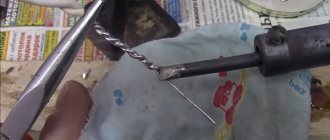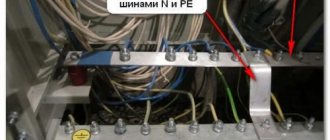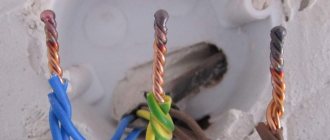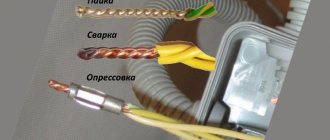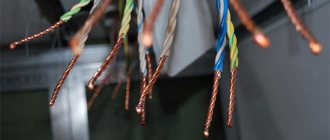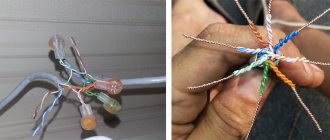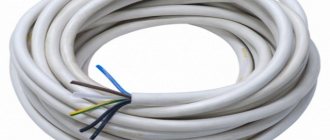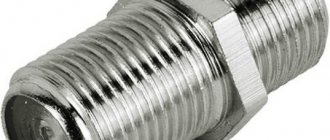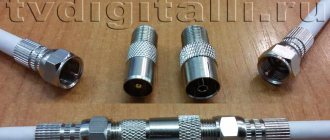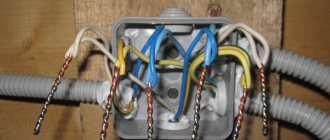Modern electrical wiring in an apartment or house is carried out only with copper wires, as the PUE says. But in old houses, wiring was most often done with aluminum wire, and a situation arises in which it is necessary to connect 2 wires of different materials. And in this article you will learn how to connect copper and aluminum wire in different ways.
Methods for connecting copper and aluminum wires
Is it possible to twist copper wire with aluminum
Let's start with the fact that is it possible to connect aluminum wires with copper wires, and will such a connection not lead to a fire? The answer is yes, you can. But let's first get acquainted with these materials.
If you ask yourself which wiring is better, copper or aluminum, then the choice is, of course, copper. This comes out of the technical characteristics of copper; the cross-section of aluminum wire under the same conditions has to be taken larger. There are also disadvantages: copper is more expensive. It is easier to distinguish copper wire from aluminum by color; copper has a reddish tint, aluminum is gray and white.
Having looked at the electrical performance of metals, the question of which conducts current better disappears. Here's some information:
- Resistivity: copper – 0.017 Ohm mm²/m, aluminum – 0.028 Ohm mm²/m.
- Heat capacity: copper - 0.385 J/gK, aluminum - 0.9 J/gK.
- Elasticity of the material: copper – 0.8%, aluminum – 0.6%.
So why can’t you twist copper and aluminum wires, because twisting, especially with a small cross-section, is the cheapest option in terms of both money and time? The thing is that these materials, when connected, create a galvanic couple.
Galvanic pair - 2 metals of different kinds, the connection of which will lead to increased corrosion. Copper and aluminum are just such a galvanic pair. The electrochemical potentials of the two metals are too different, so rapid corrosion will increase the resistance at the junction and subsequent heating. More details about the compatibility of metals are indicated in GOST 9.005-72. Below is a table with some data on metals:
Galvanic compatibility of meltals
You can achieve high-quality contact between two conductors in different ways (soldering, using a simple terminal block, more expensive WAGO terminals, or an ordinary bolt and nut).
Basic connection methods
To make correct, reliable contact between two different materials, special devices are used. They can be divided into two categories according to the presence of contact between the stranded wires:
- There is direct contact. Achieved by such methods as twisting, crimping, soldering.
- There is no direct contact. This is done using terminal blocks and threaded fixation.
To connect an aluminum wire to a copper wire, it is better to use the second option. The first method can only be implemented if the copper wires are pre-treated.
Twist
This method is used in domestic conditions for a short period of time. Twisting cables is unreliable, quickly heats up and breaks down. According to the requirements of the PUE, it is prohibited to use twisting in electrical wiring, especially when connecting two different materials.
Options for connecting wires by twisting
Soldering
Two wires of different materials can be soldered to each other. But soldering the wires is necessary only if the technological features of each material are observed. Copper and aluminum need to be prepared for soldering. Difficulties can arise specifically with aluminum conductors. A thin oxide film forms on its surface, which prevents the solder from sticking to the wires. It can be neutralized using a special device.
The end of the wire is stripped and treated with copper sulfate in the form of a solution. Next you will need a battery. A conductor is attached to the minus. The copper is installed on the plus side, the other end of the copper is placed in the solution. After some time, a coating will appear on the aluminum cable, which will allow the solder to adhere to the electrical wire. After this you can start soldering.
Crimping
When crimping wires, a sleeve or tip made of plastic or metal is put on the connection point. The sleeve and tip allow you to fix and strengthen the contact between the cores. Externally, the sleeve is an insulated tube. The tip is usually made in the form of a plastic cap into which the wires to be connected are passed. After threading the cables, the nozzle or sleeve must be crimped with press pliers.
There are nozzles with a clamping ring or a cone-shaped spring. Place on twisted wires and crimp with pliers. With the help of such crimping you can do twisting at home. The metal ring inside reliably fixes the contact between the cores.
Threaded fixation
A contact created using a threaded connection is reliable and stable. The cores are clamped together using a threaded nut. A washer is installed between the ends to prevent direct contact between the copper and aluminum.
The main advantage of the method is its simplicity and versatility. The downside is the bulkiness and inconvenience of isolation. Thanks to the threaded connection, you can connect wires with different cross-sectional areas.
Algorithm for creating a contact:
- Strip the wires from the insulating layer by 1-1.5 cm.
- Create a ring of bare wires with a diameter larger than the bolt.
- Place the rings on the bolt.
- Install a spring washer between the cores.
- The connection must be secured by tightening the nut or using a riveter.
This wiring method is great for extending the wire to a sufficient length.
Application of rivets
A rivet is a device consisting of a tube and a core. Fixed with a riveter. To create contact, the cores, as in the case of a threaded connection, are stripped and laid out in the form of a ring. These rings need to be put on a tube with a steel gasket - a washer. Then you need to crimp the rivet, the core will compress the metal together and fix the cables to each other.
This contact is permanent. Its advantages are reliability, strength and durability. The difficulty of the job lies in finding a riveter; you also need skills to work with it. Used for electrical connection of conductors in hard-to-reach places.
Contact using two steel strips
Copper and aluminum can be joined using a simple method, which first requires tinning the copper core. The wire is clamped by two steel strips, which have bolts along the edges. Advantages include the ability to connect multiple branches without increasing the length of the bolt. The exposed parts are fixed between the slats. To use this method, you need to take cables of the same diameter. The wires must be insulated.
Terminal blocks, terminal blocks
A high-quality and reliable connection can be made using terminals and terminal blocks. They are a strip made of insulating material with connectors for installing wires. Clamping is done using bolts. There is no direct contact between the cores.
A terminal box is a system of several terminal blocks. They are combined into one design and have several outputs.
Advantages:
- Ease of installation.
- High reliability of insulation. There is no need to further isolate the system.
- For reliable fixation, 1-2 cm of cable is enough.
In the case of hidden wiring, it is necessary to install a distribution box and an input machine. There are also special terminal boxes for flush mounting on sale.
All ends of the wires must be securely fixed inside the terminal block. It is especially important to securely fasten aluminum conductors when installing cables outdoors or in a room with high humidity and temperature.
Spring and self-clamping terminal blocks
You can find disposable and reusable blocks and terminal blocks on sale. Spring devices securely fix the wires using a spring, which can be loosened if necessary when installing or pulling out the wire. When the lever is lowered, the copper and aluminum are securely locked inside the terminal block. Disposable devices clamp the cables when inserted into the socket; physical force must be applied to pull them out. As a result, the spring mechanism may be damaged, making reuse impossible.
The range of disposable and reusable terminal blocks is wide. They differ in the number of connected wiring branches and the cross-section of the installed wire. Using terminal blocks is one of the most popular and convenient ways to create contact between wires.
The first terminal blocks with a self-clamping mechanism were produced by Wago. They create and sell connectors of the same name. You can find many analogues on the market, including those produced by unknown companies. Such devices can be unreliable, so it is recommended to purchase all electrical equipment in specialized stores.
Connection algorithm for Wago self-clamping terminal block:
- Remove the insulating layer from the wires by about 0.5-1 cm.
- Install the exposed part of the core into the corresponding socket of the terminal block.
- Secure the wire using a spring clamp or screw.
Additional insulation of the connection point is not required. The disadvantages of connecting with Wago blocks include the high cost of the products.
Walnut pads
There is another type of terminal block used to connect two conductors. These are “Nut” terminal blocks, which are two copper plates enclosed in a plastic case. They are used for branching large diameter cables, as well as for use in outdoor conditions.
The mechanism works simply. The cores are laid between the two plates. Then they need to be tightened using bolts. For insulation, a protective plastic case is put on top, which consists of two halves that look like a nut. The halves are also secured using standard screws.
Connecting wires
Connecting aluminum and copper wires to each other requires technological solutions; simple twisting is not enough.
Methods for connecting conductors with different electrochemical potentials:
- By soldering. But not simple soldering.
- Using simple terminal blocks or expensive WAGO. There is no point in saving money here, and if the question is how to properly connect copper and aluminum wires, then it is better to take WAGO. The advantages of this manufacturer will be described below.
- Using a bolted connection, which has many advantages: low cost, simplicity and the ability to work with large cross-section wires.
- Crimping with sleeves. Requires specialized tools.
We connect aluminum wires quickly and correctly.
How to connect two aluminum wires to each other? It would seem like a rather banal question, but even here the first answer that comes to mind is not always correct. After all, twisting of wires is prohibited according to the PUE standards, and any wires can be connected only by crimping, soldering, welding and using screw clamps. And we’ll talk about how to do it correctly in our article.
Properties of aluminum wires
But we propose to start our conversation with a quick analysis of the properties of aluminum wire. This will allow you to identify problem areas and understand possible problems during its installation.
Comparison of copper and aluminum wire
- Let's start with the advantages of aluminum wire. The main one is the price, which is an order of magnitude lower than that of its main competitor - copper.
- Another advantage of this material is its lightness. This has led to its widespread use in power lines, where weight is very important.
- Well, the last advantage is its resistance to corrosion. Aluminum is almost instantly coated with a persistent oxide film, which prevents further oxidation. At the same time, this film also has negative aspects - it is a very poor conductor of electric current.
Areas of application of copper and aluminum wires
- Then there were only continuous shortcomings. And the first of them is the low electrical conductivity of aluminum. For this material it is 38×106 S/m. For comparison, for copper this parameter is 59.5 × 106 S/m. This results in the fact that, for example, a copper wire with a cross-section of 1 mm2 is capable of passing a current almost 2 times greater than a similar aluminum wire.
- The next significant disadvantage is that aluminum wires have very low flexibility. In this regard, they cannot be used in places where the wiring is subject to repeated bending or other mechanical stress during operation.
- Well, and finally, the instructions say that aluminum has such a bad property as fluidity. As a result of thermal and mechanical influences, it can lose its shape, which has an extremely negative effect on contact connections.
Note! According to the PUE standards, since 2001 it has been prohibited to use aluminum wire for installing electrical wiring in residential premises. This ban significantly reduced the use of aluminum electrical wiring in everyday life.
Methods for connecting aluminum wires
As we said above, aluminum wires can be connected in four main ways - screw or bolt clamps, pressing, welding and soldering. Let's look at the features of each of these types of connections.
Connecting aluminum wires using the compression method
Let's start with the most common connection method - compression. It can be of several types - bolted, screw or using a pressure spring, which is used in Wago terminals.
| Screw terminal Connecting aluminum wires to each other using this type of connection has one drawback. If you use conventional screw terminals, then using a screw you can completely or partially press down the soft aluminum core. This will either reduce or completely destroy contact. |
| Brass tips To eliminate this option, the connection should be made through special contact tips made of brass. Brass has less elasticity and is more difficult to bend. Therefore, such attachments provide reliable contact and eliminate the possibility of damage to the wire. |
| Aluminum lugs For bolted connections of aluminum wire, special lugs should also be used. They are attached to a wire or cable using the crimping method and then these lugs are connected using a bolted method. |
| Wago terminals As for Wago terminals, everything is much simpler here. This type of connection cannot damage the wire, so such terminal blocks can be used without additional attachments. This somewhat compensates for their higher price. |
Connecting aluminum wires using crimping method
Recently, connecting aluminum wires with a sleeve has become increasingly popular. This is partly due to the widespread use of crimpers or, as they are also called, crimping pliers. This tool allows you to crimp wires of different sections, ensuring fairly reliable contact.
- The connection of wires by crimping is carried out using special sleeves. These sleeves are available in different diameters and materials. To connect aluminum wires, either aluminum or brass sleeves should be used. Copper should not be used under any circumstances, since the connection of these two materials can lead to the formation of galvanic isolation and ultimately the complete destruction of the aluminum conductor.
- To connect wires of different sections, there are sleeves with different diameters of the inlet holes. They can also be used to connect more than two wires in one sleeve.
- Sleeves for connecting aluminum wires have a strictly required length. Believe me, the manufacturer did not make a reserve in the sleeve, so cutting the sleeve in half in order to save money is a very bad option. After all, when connecting two wires, crimping should be done twice with opposite crimps. If you cut the sleeve in half, you won't be able to do this, and the contact will be poor quality.
- Another frequently asked question relates to connections between stranded aluminum wire and solid wire. It is possible to make such a connection using crimping, and it will be of sufficient quality. The main thing is to choose a sleeve with the appropriate inlet diameters. Indeed, in most cases these are wires of different sections.
Note! The cross-section of the sleeve for connecting wires must correspond to the cross-section of the wire. If you use a sleeve with a smaller cross-section, then to insert the wire into the sleeve you will have to reduce its cross-section, which will negatively affect the contact. If you use a sleeve with a larger cross-section than the wire, then the area of the contact connection will be much smaller, which again will lead to overheating of the contact.
Connecting aluminum wires by welding
The best quality of connection is ensured by welding. Due to the fact that in this case the wire forms a single whole, problems with transition resistances, the possibility of reducing the pressure force, and much more are practically eliminated. But there are also a lot of problems here.
- The fact is that, as we said above, an oxide film forms on the surface of aluminum. It has completely different heat and electrical conductivity than aluminum itself. In this regard, welding aluminum wires is difficult.
- Since the melting temperatures of oxide and aluminum differ, attempts to simply weld wires with a carbon electrode will not be very successful. Oxides will remain on the molten drops of aluminum, and the compound itself will not be homogeneous, as in the video.
- To eliminate this problem, you can remove oxides from the surface mechanically, but this is labor-intensive and not always effective, since the formation of a new film occurs almost instantly.
- Based on this, in most cases, various fluxes are used for welding, which can destroy the oxide film. This material should destroy the oxide film and practically not react to pure metal; in addition, it should not produce harmful compounds during welding. Selecting such material is quite difficult and often you have to make a compromise.
- But even with the use of fluxes, it is quite difficult to make a welded connection of wires with your own hands without proper preparation. This is due to the fact that it is extremely important to select the proper welding voltage (usually no more than 20V) and exposure time to the conductor (usually 1-2 seconds).
Note! In addition to electric welding of aluminum wires, gas welding is also quite common. It has its own characteristics regarding both the materials used and the welding temperature.
Connecting aluminum conductors by soldering
The last option that can be used to connect sockets with aluminum wires is soldering. This method is quite labor-intensive and can hardly be called fast.
Therefore, it is used extremely rarely for power plants, and in low-voltage networks, aluminum wires are used quite rarely due to their rigidity. Nevertheless, let's consider this option.
- The main problem here, as in the case of welding, is the oxide film. In addition, there is such a problem as the lack of visual control over the temperature of the wire. Indeed, with prolonged exposure to high temperatures, aluminum can change its physicochemical properties.
- Based on this, the process of soldering aluminum becomes quite complex. First of all, we need to get rid of the oxide on its surface. This can be done using any abrasive materials, but you should not be zealous, since a new film is formed almost instantly. Our task is only to reduce its thickness.
- After this, the wires are fixed and solder and flux are touched to the wires. It is better to use TsOP-40 or its analogues as solder.
- Flux for soldering aluminum is F - 59A, F - 61, F - 34 or other similar compositions. They destroy the oxide film quite well.
- When the solder touches the wires, they should be scraped across them to make it easier for the flux to break down the oxide film. If soldering is performed without using flux, then the intensity of friction of the solder on the wires should be more intense.
Conclusion
Connecting aluminum wire with a sleeve and using terminals are the simplest options. At the same time, the use of crimping does not require additional materials, but requires the presence of a crimper.
The use of pliers and other auxiliary tools may affect the quality of the connection, so their use is unacceptable. However, when comparing price and quality, the crimping method is one of the best for connecting aluminum wires.
WAGO
WAGO clamps for joining aluminum and copper are very popular, as they are very convenient to use:
- Click the pressure plates to the side.
- Insert wires into holes.
- Place the plates in their places and clamp them.
WAGO terminals for connecting copper wire to aluminum are an excellent solution
But now WAGO is casting doubt on its reputation. According to numerous reviews, the spring contact weakens, which leads to burning of the terminal block and its rapid replacement.
galvanic pairs of metals
galvanic pairs of metals
Galvanic pairs of metals
The atmospheric corrosion resistance of aluminum is explained by the presence of an oxide film formed immediately after the metal interacts with atmospheric oxygen (Liter.: V.F. Henley “Anodic oxidation of aluminum and its alloys”).
Table 1 Compatibility of metals and alloys
P - compatible when soldering, but incompatible when in direct contact, since they form a galvanic couple
POS - tin-lead solder
Example of unwanted galvanic pairs:
1 PAIR: aluminum and all alloys based on it are not recommended and cannot be combined:
2 PAIR: aluminum and all alloys based on it are not recommended and cannot be combined:
- with titanium and its alloys
3 PAIR: magnesium-aluminum alloys are not recommended and cannot be combined:
- with alloyed and unalloyed steel
4 PAIR: zinc and its alloys are not recommended and cannot be combined:
5 PAIR: nickel and chrome are not recommended and cannot be combined:
6 PAIR: unalloyed steel, tin, lead, cadmium are not recommended and cannot be combined:
Figure 1 - Galvanic corrosion of two parts made of dissimilar metals
Galvanic corrosion of a more active metal begins when two or more parts of dissimilar metals that are in mutual contact (either through normal contact or through a conductor) are placed in an electrolyte (any liquid that conducts electricity). The electrolyte can be anything except chemically pure water. Not only salty sea water, but also ordinary tap water, due to the presence of minerals, is an excellent electrolyte, and its electrical conductivity only increases with increasing temperature.
The cathode is the electrode on which the reduction process occurs, and the anode is the electrode where oxidation processes occur.
Metal activity series (electrochemical voltage series of metals)
2 - Medium activity metals
Chemical corrosion - metals protect themselves with an oxide film on their surface, whether it is self-healing is the question, as in the case of aluminum, stainless steel, non-ferrous metals, or as steel separates.
Fig 2 - multilayer panel based on cellular or corrugated aluminum “Perfaten”
Figure 3 - corner connection of a sandwich panel
Source
Twisting wires
Twisting aluminum and copper wires was previously mentioned as a very unreliable connection method, but sometimes this is the only way to quickly restore power supply.
A couple of tips before twisting:
- Before twisting, the copper wire should be well tinned.
- The amount of twist must be at least 5 turns.
- After work, the joint must be protected with several layers of insulating tape or heat shrink tubing.
Soldering copper to the terminal block
You can solder copper and aluminum together. If everything is clear with copper, then for soldering aluminum you need a special flux. Some electricians simply solder copper wire to the terminal block.
Flux for aluminum
Why you can’t combine copper and aluminum in electrical wiring
Aluminum electrical wiring performed all its functions in old houses. Previously, electronic devices did not require much power. But with the development of technology, the load on wires and sockets began to increase, which is why we had to look for new materials that can operate under high voltage. This leads to the fact that it may be necessary to extend the aluminum cable with copper.
It is impossible to connect aluminum and copper wires directly. First of all, the incompatibility is related to the properties of aluminum. It oxidizes and breaks down faster. When combined with copper, the destruction process occurs faster. Heating occurs due to the fact that the resistivity of aluminum is higher than that of copper. Aluminum is also softer and has lower electrical conductivity.
Copper and aluminum are galvanically incompatible. When touched, a chemical electrolysis reaction occurs, which worsens the contact. The connection point oxidizes or heats up, the insulating layer is destroyed, which increases the risk of a short circuit or fire. The process accelerates in conditions of high humidity.
Terminal blocks
The list of electrician tools and consumables includes terminal blocks. Terminal blocks are copper or brass coated with a layer of nickel, designed for wires of a certain cross-section and covered with a layer of insulating plastic. The wires are secured with 2 small screws.
When connecting copper and aluminum terminal blocks, the locking screws must be properly tightened. If you tighten them, you can damage the aluminum conductors, which will not have a very good effect on the further operation of the electrical wiring. Therefore, it is necessary to find a middle ground: not tighten too tightly, but achieve high-quality contact.
How to solder ferrous metals
Products made of ferrous metals also lend themselves well to soldering. Tin and brass solders are used to connect them. The connection is sufficiently tensile strength and also resistant to mechanical damage.
The technology for soldering ferrous metals is practically no different from the technology for soldering products made of copper, aluminum or brass. Here, you also need to prepare the surfaces: clean them of rust, dirt, and greasy stains.
If soldering steel is carried out with a conventional soldering iron, then you will need a tool with a power of at least 100 W. Otherwise, the soldering iron will not be able to heat the workpieces being soldered well enough, which will negatively affect the strength of the resulting connection.
Bolted connection
If you don’t have a terminal block, soldering iron or WAGO at hand, and the cross-section of the wires is large enough, then you can achieve high quality with an ordinary bolt.
To connect two wires you will need: a bolt, a nut, 3 washers. Sequencing:
- Make rings at the ends of the wires, the same diameter as the bolt. For convenience, it is better to use round nose pliers.
- Place the rings on the bolt in such an order that they are between the three washers.
- Tighten the nut and check the quality of the connection.
- Apply several layers of insulating tape.
Bolted connection of aluminum and copper
Nut connection
"Nut" is another type of terminal block, most often used for branching large-gauge wires. It consists of 2 copper plates placed in a plastic case.
Copper and aluminum wire, as well as a branch wire, are placed between the plates. But you can simply use the “nut” as a connecting element. After laying the conductors, the plates are tightened with bolts. As insulation, a plastic case is placed over the entire structure, consisting of two halves, for fastening which standard screws are used.
Walnut connection is suitable for all types of street connections and branches
Crimping
For this method you will need special crimping pliers and sleeves. The principle of connecting wires with a sleeve is very simple: an aluminum wire is inserted into the sleeve on one side, a copper wire on the other, and the sleeve is crimped on both sides with pliers. There are sleeves for wires with a large cross-section - from 16 mm2 to 300 mm2, but in this case a special hydraulic press will be required. The only drawback of crimping is the high cost of the tool.
Special sleeve for connecting aluminum and copper
Lubrication
To improve the quality of contact, you can use a special lubricant or paste. Usually this is quartz vaseline paste. It is usually used to improve the connection of aluminum wires.
But this paste can be used for all types of connections (threaded, using terminal blocks, crimping), especially if the connection takes place outdoors. Then the contact is affected by additional factors that significantly reduce the durability of the connection. Although the use of lubricant without insulation raises doubts.
How to protect a structure or assembly from contact corrosion?
If for design reasons it is not possible to avoid unwanted contact of dissimilar metals, then attempts can be made to reduce galvanic corrosion using the following methods:
- painting surfaces in the area of their junction;
- application of compatible metal coatings;
- isolation of the connection from the external environment;
- electrical insulation;
- installation of non-metallic gaskets, inserts, washers in bolted joints.
Practice shows that in cases where the requirements for the admissibility of contacts of different metals are neglected, one has to pay dearly for this. Incorrect arrangement of contact pairs damages fastening units and metal structures and can cost human life.
«>
